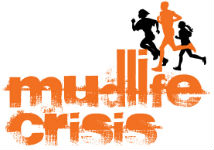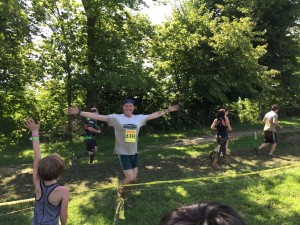Two weekends ago, I completed my latest Mud Ninja race. And though it wasn’t my most successful race as far as obstacle completion and time go, it was a complete success from a level that I didn’t even consider at the time, but was a lesson I realized a few days later.
If you’re not familiar with the Mud Ninja, it’s easily my favorite Obstacle Course Race (OCR) that I run each year. It’s local to central Ohio, and it’s a fund-raiser for Autism Speaks. Mostly I’ve run it by myself, though two years ago I had a fantastic team with me to run it. Either way, it’s super fun.
But this year it was a little tough. I’d been feeling a bit down of late, and my training hasn’t been quite what it should have been. I didn’t feel as confident going to the starting line as I normally have. Usually, I know that I’ve worked hard and smart – incorporating my love of bodyweight exercises and movement work such as MovNat into the mix. This year, though, I didn’t have as strong a feeling. My technique was fine, but I wasn’t feeling as powerful as I’d like.
But I surprised myself at the outset. I won’t say I coasted through the first half of the race, but let’s just say I was feeling really good to get going. The course is basically set up around a pair of ravines, with obstacles at the bottom on both sides and up at the top, with LOTS of climbing as you’re going. You can’t always see where you are as you’re climbing which adds to the mental aspects of the experience. And then there’s the mud.
It’s not called Mud Ninja for nothing. Most OCR courses have 2-3 muddy obstacles (out of a total of 15-20) in them. Mud Ninja has at LEAST 12-15 mud obstacles. You’ve pretty much given up trying to stay clean after obstacle number two, whatever that happens to be that year (they move things around so that it’s not the same course each iteration. So you get into the habit of cleaning off your hands at the very least after each obstacle so that you have some grip in case the next obstacle requires it.
So it’s challenging. VERY challenging. My wife ran into a scout from the Tough Mudder last year who was looking at some of the obstacles and wondering “Why didn’t we ever think of that?” (and then I kid you not, we saw that obstacle in the videos for Tough Mudder this year).
But I was moving well – took the obstacles in the first half and all of the down-and-up climbing and was feeling top notch as we hit the halfway mark. But…
This year they added a new wrinkle – the decision to really push the grip-based obstacles this year. The middle of the course, which was back up in the area between the two ravines, had a series of four obstacles that showed me just how unprepared I really was – especially after I was doing so well in the first half. The first was a partner climb over an 8′ diameter pipe – sort of a culvert or large drain pipe, the kind that a highway drainage ditch would run through if it went through an overpass. You slid down the other side into the water. You needed help to get over it because you were wet and muddy, and it was slick. (This was the one that caught the eye of the fellow from Tough Mudder, by the by…)
The second was a series of five ropes hanging free in front of you, each with a fragment of tire hanging on the end. One tire was hanging at chest level, then the next a foot level, then back to chest level, back to foot level, and back to chest level. You were supposed to swing from one to the next, but the tires sort of got in the way so it was a lot harder to get momentum for the swings as you made your way across. I did not succeed at this one, as my grip strength simply wore out as I fell once (into four-foot deep muddy water, might I add) and then again as I didn’t want to give up.
The third was the “Ninja Warrior” obstacle. Imagine a platform about 15 feet high, with a cargo net hanging about halfway down to the pool of water in front of it (about 6 feet wide). There were also knotted ropes leading up to the bottom of those cargo nets, and on your side of the pool were a series of gymnastics springboards. The idea was that you jumped from the springboard over the pool and tried to grab the cargo netting, and pulled your way up to the top of the platform. Well, the past two years I whiffed on the springboard and had to climb the ropes out of the water and onto the cargo net. This year… I actually succeeded on the springboard and got to the cargo net! But only with my hands, not my feet. And after that first obstacle, I didn’t have anything left to pull myself up. Another failed obstacle.
The final one of that series was new to Mud Ninja this year: a “warped wall” type obstacle. If you’ve ever watched the TV show American Ninja Warrior you know what I’m talking about.
It’s sort of a 15′ high curved wall, like a skateboarder’s half-pipe, that you ran up and tried to grab the top of. The only difference between this obstacle and the TV version was that there was an approximately six-foot knotted rope hanging from the top to help you up.
I took a minute or two before trying this one to rest my arms… I was gassed. But I’d done this sort of obstacle very successfully at the Savage Race (their equivalent obstacle is called The Colossus) two years ago and was feeling confident. I ran… I grabbed the rope… and that was it. I had nothing left. I held myself there for probably a bit too long, and then slid down.
I tried again… and slipped on the muddy surface going up – smashing my hand against the wall. (It still hurts slightly as I’m writing this a week later). But the third time, I made the decision not to aim for a point on the rope and just to go for the top. My run was dead on, and I actually got higher on the rope than I did the first time. I pulled myself up with my last ounce of strength, got a leg over the top, and rolled up onto the platform. I was two-of-four on the top four obstacles, and I wasn’t happy about it – particularly since I missed the Ninja Warrior obstacle for the first time since they introduced it.
That had me down. I finished the race, and actually my time wasn’t too bad. But I was upset that I’d missed those two obstacles. It was haunting me a bit, and did for the next couple days. It was the first time that I’d ever really failed at an obstacle in a race that I felt I should have been able to complete.
That all changed as I was listening to my podcasts a few days later. One of the podcasts I listen to is called “Rewild Yourself,” by a very smart and entertaining pundit of “getting-back-to-nature” type living named Daniel Vitalis. He and his guests inspire a lot of the topics I take on with this site, to be frank.
This week, he was talking to – of all people – Erwan Le Corre, the founder of MovNat. But this wasn’t a talk about movement per se… it was very much a talk on growing up and becoming an adult. Erwan was discussing his lifestyle, his family, having kids, and the idea of different rituals that take a person from one stage of life to another. Back before the advent of agriculture, these sorts of rituals or initiations could be grueling and life-changing. Think Gerard Butler as Spartan King Leonidas in 300, fighting a wolf as part of his “year in the wild” initiation in the early part of the movie.
But they didn’t have to be like that – they could also be initiations that challenged the person on a psychological level. This might be something more like a sweat lodge or the intake of substances like peyote, or ayahuasca – some sort of entheogen that opened the mind. In either way, the participant’s mind was challenged with a psychological event where deep-set fears and issues were brought to the forefront and forced the participant to confront them.
It really got me thinking. We have a lot of things that are considered coming-of-age ceremonies in our society. Starting school, getting your driver’s license, graduation from high school and maybe college, getting your first job, getting married and having kids, etc. are all things that many of us consider a rite of adulthood.
But listening to Erwan and Daniel discussing what initiations really are got me thinking about these things in a different way. To be frank, a lot of that sort of stuff just “happens” as you get older in our society. It’s not always a challenge (sometimes it is, don’t get me wrong – I know plenty of people for whom graduations, for example, were very hard, but in general…) to complete. It’s just a more-or-less age-based event that you are going to go through, one way or another.
But the types of events these guys were talking about were on a different level all together. They were really forcing introspection and the confrontation of one’s fears. They were challenging people in a way that was leaving them a different person on the other side.
I think that the lack of things like this (again, in general – I don’t think there’s a person in the world who isn’t going to admit that the first time someone is in combat or a life-threatening situation, they’re not going to be the same person when they’re done) in our modern society is part of why we’re always looking for some sort of escape. Some people escape in a death-defying way – think extreme sports and the like. Some people look for it in sports. Some people gravitate to video games, or shopping, or heck, even throw themselves into entrepreneurship or business success.
I looked for it in obstacle course racing. I think I want to test myself in ways that will let me know just how strong I am and can be. And, for the first time, I learned about how I need to improve myself in order to overcome a failure in this endeavor – the failure of not being adequately prepared for a race. Perhaps I’ve coasted by with a minimum of preparation in the past but that’s not going to cut it as these races get harder and harder. And I’m not even talking about them getting harder because I’m getting older, I’m talking about the races finding new ways to challenge us.
Or maybe it’s a bit of both – the races are getting harder AND I’m getting older, which will make me need to take more care and time to prepare for them.
Either way, I’ve learned something and come to grips with a fear of failure that I may not have known I had until it actually happened – and I was forced to deal with it. I could have said “no, no more of these races for me.” Or I can stand up and say “I am going to be ready next time, and I’m going to figure out the best way to be ready.”
It was quite the epiphany. It may even have something to do with the sorts of experiences that a “Neuro-Associative Conditioning” event can cause, as I discussed in our introductory “Why Obstacle Course Racing?” post. It could be, even though I thought I’d taken on such an event earlier in my life, that I’d really not experienced such an event until now.
And though I’m still pissed about missing those two obstacles, I’m now glad that it happened. I have the opportunity to overcome those issues and do it smartly and methodically. And I’m going to pull through and conquer them next time I come across them. It’s caused me to confront fears of getting older and having to work harder and smarter, perhaps, just to keep up with the stuff I love to do.
Not necessarily a bad thing to discover about yourself, right?
What sorts of challenges have you had that have made you face your fears? How did you overcome them? Share below in the comments, and please share this article with someone today!








